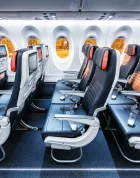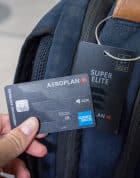With the launch of the Chase Aeroplan Card, Air Canada’s loyalty program will be on the forefront of American travellers’ minds.
Aeroplan has been accessible to Americans for a while through transferable points, but with so many other award travel options available, it’s easy for Aeroplan to get lost in the crowd.
Now, with an impressive signup bonus and perks on the new co-branded card, the value proposition of Canada’s best frequent flyer program is too good to keep ignoring.
Let’s explore some unique ways that Americans can benefit from using Aeroplan for flight rewards, including sweet spots compared to award pricing with other popular programs.
In This Post
- US Miles & Points Background
- North America
- South America
- Europe & Middle East
- Asia & Oceania
- Adding a Stopover
- Etihad Airways
- Lap Infant Awards
- Conclusion
US Miles & Points Background: Aeroplan vs. US Airlines
In Canada, Aeroplan is the name of the points game. There are so many ways to earn Aeroplan points, and so few other compelling travel rewards.
You can redeem for flights to destinations serviced by the largest network of airline partnerships in the industry, and it’s the only truly global loyalty program that we have. Many Canadians can’t easily look for alternatives, nor do they need to.
Earning: US Banks & Transferable Points
Meanwhile, the US landscape is much more competitive. There are four major national airlines – Alaska, American, Delta, and United – with globally-relevant frequent flyer programs.
And there are four major banks – Amex, Capital One, Chase, and Citi – with a multitude of airline transfer partners.
With so many transfer partners who can book overlapping award availability or who fly to the same destinations, it’s often wise to focus on bank rewards and transfer them when you’re ready to make a booking, instead of putting all your eggs in one airline’s basket.
In addition to earning Aeroplan points directly with the Chase Aeroplan Card, you can transfer points to Aeroplan at a 1:1 rate from Amex Membership Rewards, Capital One miles, or Chase Ultimate Rewards. That should give you a wide variety of earning strategies to choose from, and it puts Aeroplan on equal footing with the most easily-obtainable US rewards currencies.
United and Delta have partnerships with Chase and Amex respectively. Both have a plethora of personal and business co-branded credit cards available, plus the ability to transfer bank rewards to frequent flyer miles.
In particular, United is a Star Alliance member, so I’ll make it our primary point of comparison. You can book the same partner award availability with Aeroplan and United MileagePlus.
American and Alaska have co-branded cards with Citi and Bank of America respectively, but neither have a bank transfer partner, so they’ll require a different strategy to earn quickly. They usually have great value, but they’re harder to compare head-to-head with Aeroplan.
Finally, there are a number of international frequent flyer programs with no co-branded credit cards from major US issuers, but plenty of transfer partners.
These are often best used for niche redemptions, when hunting a specific sweet spot. Here are a few of the programs with a global presence and two or more bank transfer partners:
- Air France/KLM Flying Blue (Amex, Capital One, Chase, Citi)
- Avianca LifeMiles (Amex, Capital One, Citi)
- Etihad Guest (Amex, Capital One, Citi)
- Singapore Airlines KrisFlyer (Amex, Capital One, Chase, Citi)
- Turkish Miles & Smiles (Capital One, Citi)
- Virgin Atlantic Flying Club (Amex, Chase, Citi)
Redeeming: Award Charts vs. Dynamic Pricing
There are two unshakable truths about award pricing: transparency is a virtue, and dynamic pricing is almost always worse value than an award chart.
Aeroplan publishes an award chart based on a mix of region-based and distance-based pricing. You’ll pay a dynamic price for Air Canada flights, or a fixed price for partner redemptions within each region and distance band.
Alaska’s method is similar, with distance-based dynamic pricing on their own domestic routes, and individual region-based charts for each airline partner.
American publishes two region-based charts, one for their own flights (with dynamic pricing) and another for partner flights.
United and Delta don’t publish award charts at all. That means they can charge whatever they like, and they can change these prices on a whim. Relentless search engine inquiries have revealed that both airlines operate with a dynamic model for their own flights, and fixed region-based pricing for partners.
For this exercise, we’ll mostly be looking at fixed-price partner awards. I imagine many Americans won’t be heavily impacted by Air Canada’s dynamic pricing – the US has many major international airports serviced by global airlines, so Americans won’t need to transit a Canadian hub to make a good redemption on a Star Alliance route.
Aeroplan’s sweet spots tend to lie its fixed-price awards on partner airlines. I encourage you to compare these rates with other rewards programs at your disposal.
Without further ado, let’s look at some of Aeroplan’s sweet spots which might be useful to Americans.
I’ve broken them down by Aeroplan’s four regional award charts: North America, South America, Atlantic (Europe, Africa, the Middle East, and the Indian subcontinent), and Pacific (Asia and Oceania), followed by a few universal cases and special opportunities.
Unless otherwise specified, all redemption amounts are quoted for one-way flights in business class.
North America
Here’s the Aeroplan award chart for flights within North America:

Generally, you’re at the mercy of the airline for North American flights, no matter who you book with.
Book with Aeroplan or United on their own flights, and you may face high dynamic pricing. Book with them on each other as a partner redemption, and you’ll be limited by partner availability.
Still, there are a few opportunities to be aware of in case they come up.
Short-Haul to Canada
For a quick hop over the border, you can’t beat Aeroplan’s price for North American flights under 500 miles flown in economy class.
With United, you’ll be lucky to find flights from New York to Toronto for less than 12,500 points.

Instead, with Aeroplan you’ll pay as low as 6,000 points if dynamic pricing is in your favour.

If you live further from the border, you can still take advantage of great rates for longer flights. Air Canada’s dynamic pricing sometimes dips below the bottom of the published range, cheaper than the fixed price for using Aeroplan points for partner awards.


This sweet spot is better for Air Canada flights, as using Aeroplan points for short-haul United flights would incur a CA$39 partner booking fee, which may negate the points saved.
Transcontinental Business Class
A round-trip transcontinental journey in business class costs 50,000 Aeroplan points – conveniently, the exact value of one Welcome Flight Reward Certificate.
With Aeroplan points, you can book Air Canada Signature Class or United’s Polaris seats, which are among the best business class experiences for travel within North America. In particular, look for Air Canada Boeing 777 and 787 flights with lie-flat seats, or United’s 787-10 routes.

United doesn’t release much award space to partners on routes within North America, but if you find any, it would be a great use of Aeroplan points.
Otherwise, with Aeroplan you can book any seat on Air Canada, not just saver fares. You’ll be subject to dynamic pricing on these seats, but you can sometimes find them for just a few thousand points more than the base price, whereas other programs usually have a more prohibitive jump once saver fares are gone.
Air Canada tends to be fairly generous with award space on its lie-flat products operating from Los Angeles and San Francisco to Toronto.
The schedule currently seems to have a majority of flights operating on smaller planes due to low demand, so it might be worth hopping up to Vancouver in order to snag a seat in Signature Class.
(You won’t be charged more points for taking a detour, as long as the whole itinerary is on Air Canada.)
Sun Destinations
This sweet spot also includes travel to Mexico, Central America, and the Caribbean – which is something of a rarity for North American frequent flyer programs. As long as your one-way journey is under 2,750 miles in distance flown, you’ll pay 25,000 Aeroplan points.
Specifically, look for routes to Panama City on Copa Airlines. You’ll find this price on award tickets departing from anywhere east of the Rocky Mountains.

This price beats United’s rate of 33,000 miles, or Delta’s rate of 35,000 miles, by a decent margin.
Unfortunately, Aeroplan points won’t be as useful on United routes to the tropics. Either you’ll find high dynamic pricing which can only be booked through United MileagePlus, or you’ll find saver availability which is cheaper if booked via United MileagePlus anyway.
Alternatively, you could transit Canada if you find that Air Canada’s dynamic pricing is friendlier than United’s.

South America
Here’s the Aeroplan award chart for flights between North America and South America:

Aeroplan has just two distance bands for the North America–South America chart, priced at 50,000–60,000 points with a breakpoint at 4,500 miles in distance flown. This is roughly how other programs divide the continent as well.
Overall, it’s hard to find good value for award redemptions to South America. Cash fares are reasonable, the continent’s airlines won’t turn many heads, and US frequent flyer programs offer great points rates themselves.
Instead, look to push the limits of your Aeroplan ticket, and take advantage of the slim points surcharge for uncapped mileage to the far reaches of the continent.
Star Alliance will take you as far south as Buenos Aires. With Aeroplan, you’d pay 60,000 points from anywhere in the US. You could fly from New York on Avianca via Bogotá, or on Copa via Panama City.

By doing so, you’d dodge United’s price of 66,000 miles on a partner, or a potentially higher dynamic fare on their own metal via Houston.
And let’s just pretend that Delta doesn’t even fly to the continent, as they charge 95,000 points in business class to all South American destinations! (Thankfully economy is more reasonable, even beating Aeroplan.)
Again, flights to South America will come in at or just over the maximum value of a Welcome Flight Reward Certificate, making these routes a good way to burn vouchers for good value if you’re short on points for something bigger.
Europe & Middle East
Here’s the Aeroplan award chart for flights between North America and the Atlantic zone:

Aeroplan’s award charts aren’t overwhelmingly strong for travel to Europe, but there are still a few pockets of value.
Short Flights to Europe
Because the Aeroplan charts are distance-based, and the North American continent is about as wide as the Atlantic Ocean, your value will depend on your point of departure. Flights from the East Coast will take you further for the same points price.
As a baseline, it costs 77,000 United miles for any flight in business class on a partner airline from North America to Europe, or (brace yourself) 120,000 Delta SkyMiles.

Starting on the low end, Chicago to Lisbon comes in just under the first breakpoint on the Aeroplan chart, at a cost of 60,000 points for less than 4,000 miles flown.

In general, travel from the East Coast to Western Europe is an easy way to use up a Welcome Flight Reward, with flights coming in a bit over the voucher’s 50,000-point maximum value.

At the next distance band, you’ll pay 70,000 Aeroplan points for up to 6,000 miles flown – still beating United and Delta. That’ll take you from California as far as Munich on Lufthansa, or from the eastern seaboard to Istanbul on Turkish.

East Coast to Middle East & South Asia
Many frequent flyer programs, including United, treat the Middle East, Central Asia, and the Indian subcontinent each as their own regions, with higher points prices from North America.
Aeroplan, however, combines them into the “Atlantic” region with Europe, within which prices are simply distance-based.
Based on where United draws the line between Europe and Asia, New York–Istanbul costs 77,000 miles in business class, whereas New York–Istanbul–Tel Aviv costs 93,500 miles with just a short flight tacked on.

On the other hand, Aeroplan charges 70,000 points for either itinerary, as both come in under 6,000 miles flown on the North America–Atlantic chart.

Boston–Istanbul–Baku is about as far as you could push this sweet spot, so pack up your chowder and start making plans for a trip to Azerbaijan.
But even at the next price point, 85,000 Aeroplan points for up to 8,000 miles flown, you’d still come out ahead of the price you’d pay with United, with quite a bit more mileage at your disposal.
You could fly from the West Coast to the Caucasus for this rate, beating United once again.

Or for travel to South Asia from the East Coast, you could fly as far as Washington–Frankfurt–New Delhi for 85,000 Aeroplan points, in Lufthansa business class the whole way.

Asia & Oceania
Here’s the Aeroplan award chart for flights between North America and the Pacific zone:

You can’t go wrong with any business class product en route to Asia. These are arguably Aeroplan’s best sweet spots.
Pacific Northwest to Japan
First, let’s highlight the cleanest sweet spot in the Aeroplan program: flights between North America and the Pacific region shorter than 5,000 miles for only 55,000 points. That includes ANA’s direct route from Seattle to Tokyo, serviced by its Boeing 787 aircraft.

Departures from Portland can also squeeze in at this rate, although there’s no Star Alliance flight between Portland and Seattle, so you’d have to travel through Vancouver instead.
This is only one Welcome Flight Reward plus 5,000 points, so two flight certificates from the Chase Aeroplan Card’s signup bonus plus 10,000 points for signing up for the waitlist is enough for a round-trip flight to Tokyo in business class, or one-way tickets for two passengers.
Compared to paying 88,000 United miles for the same partner redemption, or 120,000 Delta SkyMiles on a similar route, Aeroplan is a clear winner.

If you’re departing from further east, you’d only pay 75,000 Aeroplan points for a flight to Japan under 7,500 miles.
Even at a higher cost, it still handily beats the other airlines, with ample mileage wiggle room for anyone whose home airport isn’t serviced by ANA to tack on a positioning flight on the same ticket.
Direct Flights to Australia & New Zealand
It can be hard to travel to Australia and New Zealand on points, but if you’re able to find a seat, there are some good prices to be had with Aeroplan.
For itineraries to the Pacific region under 7,500 miles flown, you’ll pay 75,000 Aeroplan points. Here are a few routes you could capitalize on:
- San Francisco or Los Angeles to Sydney (United)
- San Francisco to Auckland (United, Air New Zealand)
- Los Angeles or Houston to Auckland (Air New Zealand)
That’s great value on paper, but you’re also contending with tough award availability on two airlines that are extremely stingy.
Southeast Asia and Beyond
Perhaps our favourite Aeroplan sweet spot is for flights between North America and “Pacific Zone 3”. You’ll pay 85,000 points for any business class journey under 11,000 miles.
That’s a whopping mileage allowance, enough to cover just about any itinerary from all corners of the US.
For example, you could enjoy EVA Air business class, one of the best transpacific products in Star Alliance, boasting comfortable seats and an impressive food and drink menu.

Then carry on to your final destination while staying well within the mileage threshold, even from an origin as far as New York.

Or if you’re having trouble finding availability to Australia, try taking a circuitous route from California around the Pacific Ocean on ANA.

This has a pronounced advantage over United, which charges 99,000 miles to Southeast Asia. And it’s not even worth mentioning Delta’s worst offence yet: charging 165,000 miles for a one-way redemption!
Unlike the Atlantic region, where sweet spots are about squeezing every last mile to your destination, Pacific 3 gives a lot of leeway. With many desirable destinations in close proximity, and a wide distance band at the same points price, most direct routes will leave you with some mileage to spare.
That’s a boon for anyone travelling from the Midwest, where you’ll need a positioning flight to get to an international gateway.
With many appealing airlines in the region, you could try a series of long layovers, at no extra cost.

On that note, this sweet spot is ideal for…
Adding a Stopover
In addition to an appealing fixed-price award chart, you can add a stopover anywhere (excluding Canada or the US), in any class of service, for 5,000 Aeroplan points.
You’re allowed one stopover on each one-way bound. For simplicity’s sake, a one-way bound can be thought of as a non-circuitous series of flight segments where the price of the entire series is determined by the origin and destination.
Let’s say you’re travelling from New York to Bali on EVA Air with a layover in Taiwan. For a route under 11,000 miles, this falls within the “Pacific 3” sweet spot of 85,000 points in business class.
You could change your layover to a stopover for an extra 5,000 points, bringing the total cost of your New York–Bali journey to 90,000 Aeroplan points without breaking the one-way bound. That’s a very reasonable trade-off for an extra destination, where you can stay up to 45 days.
Or if you’re coming from Seattle, you could pay the “Pacific 2 plus stopover” rate of 80,000 Aeroplan points for an extended stay in Tokyo and onwards to another destination.

Unlike with Alaska, you’re not restricted to stopping at the partner’s hub. For example, if a portion of your ticket is Lisbon–Barcelona–Athens, you could fly in and out of Barcelona on TAP and Aegean, and have no trouble booking a stopover there.
Meanwhile, United has a very complicated stopover policy, and Delta and American don’t allow them at all. If you’re planning a complex round-the-world trip, Aeroplan is a great option, with clear policies and low prices for stopovers, no matter where you go.
For now, you’ll need to call Aeroplan to book itineraries with stopovers, but we’re eagerly anticipating the rollout of new features on the website to do it ourselves.
Etihad Airways
While Etihad has indefinitely grounded its fleet of Airbus A380s – and with it the ultra-luxurious First Class Apartments – their business class and other First Class cabins are still exceptional products on which to transit through the Middle East.

As it’s not a member of an alliance, there aren’t many ways to book Etihad flights on points. Instead, they have individual partnerships with a handful of airlines. Aeroplan is one of those partners.
You can book award travel with Etihad Guest, a transfer partner of Amex, Capital One, and Citi. However, booking with Aeroplan will cost you fewer points for pretty much any route, while also saving you hundreds of dollars in fuel surcharges.
Here are a few examples that stand out:
- Chicago to Bangkok in business class for 85,000 Aeroplan points
- Yes, you can fly the “long way” around with Aeroplan: this itinerary falls within the “Pacific 3” sweet spot despite crossing the Atlantic to transit Abu Dhabi.
- New York to Sydney in 28 hours of First Class for 140,000 Aeroplan points
- JFK–AUH and AUH–SYD were both serviced by the A380, should it ever take to the skies again.
- Abu Dhabi to Johannesburg for 45,000 Aeroplan points in business class, or 65,000 Aeroplan points in First Class
On some routes, you can find even lower rates with American AAdvantage. But if your strategy revolves around transferable points, Aeroplan is a clear winner over Etihad Guest.
Ultimately, just having the ability to book such an exclusive aspirational redemption is sweet enough at any price.
Lap Infant Awards
Finally, here’s an itty-bitty sweet spot for new parents who fly with children under two years of age, but it might be the biggest value of them all.
Many airlines and award programs allow you to book a ticket to travel with your infant in your lap at a greatly-reduced price, rather than paying a full fare for their own seat.
You can do so on an Aeroplan redemption for no cost within Canada and the US, or a flat rate of 2,500 points per direction of travel for other destinations.
In comparison, many other programs accessible to US cardholders, including American AAdvantage, ANA Mileage Club, Singapore KrisFlyer, and Emirates Skywards, charge 10% of the adult revenue fare for a lap infant on an international or partner flight.
Given that those are the routes that tend to have astronomical cash costs, 10% could still be a very steep price – I’m certainly not booking an infant in my lap on Cathay Pacific First Class for US$2,000!
For young families facing the unique challenges of ambitious worldwide travel, the low rates on lap infant awards might tip the scales handily in Aeroplan’s favour.
(It’s worth noting that United is also quite competitive in this area, although you may have to pay up to US$250 for a lap infant depending on your route.)
Conclusion
As you can see, there’s no shortage of creative ways for Americans to make valuable redemptions with Aeroplan points, whether you use the program for edge cases or make it a pillar of your rewards strategy.
In summary, Aeroplan out-competes Alaska on stopover policies, American on transfer partners, United on their partner award chart, and Delta… well, the less said about Delta’s award prices, the better!
With a wide array of transferable points and co-branded credit cards available, it’s often not easy to figure out the optimal way to use your points. With a bigger credit card presence in the US market, Aeroplan will certainly attract more interest from Americans over time as they find ways to cover for the weak spots in their frequent flyer programs at home.




















